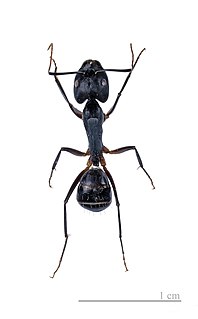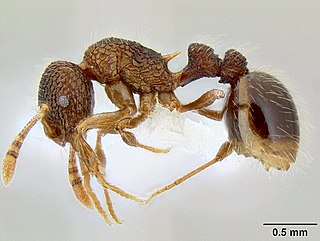
The Formicinae are a subfamily within the Formicidae containing ants of moderate evolutionary development.

Myrmeciinae is a subfamily of the Formicidae, ants once found worldwide but now restricted to Australia and New Caledonia. This subfamily is one of several ant subfamilies which possess gamergates, female worker ants which are able to mate and reproduce, thus sustaining the colony after the loss of the queen. The Myrmeciinae subfamily was formerly composed of only one genus, Myrmecia, but the subfamily was redescribed by Ward & Brady in 2003 to include two tribes and four genera: An additional three genera, one form genus, and 9 species were described in 2006 from the Early Eocene of Denmark, Canada, and Washington.

Nothomyrmecia, also known as the dinosaur ant or dawn ant, is a rare genus of ants consisting of a single species, Nothomyrmecia macrops. These ants live in South Australia, nesting in old-growth mallee woodland and Eucalyptus woodland. The full distribution of Nothomyrmecia has never been assessed, and it is unknown how widespread the species truly is; its potential range may be wider if it does favour old-growth mallee woodland. Possible threats to its survival include habitat destruction and climate change. Nothomyrmecia is most active when it is cold because workers encounter fewer competitors and predators such as Camponotus and Iridomyrmex, and it also increases hunting success. Thus, the increase of temperature may prevent them from foraging and very few areas would be suitable for the ant to live in. As a result, the IUCN lists the ant as Critically Endangered.
John S. Clark was a Scottish-born Australian entomologist and myrmecologist known for his study of Australian ants. Born in Glasgow, he developed an interest in entomology at a young age. Clark first arrived in Australia in 1905 and originally worked for the state railways in Queensland. He developed an interest in ants shortly afterwards, collecting his first specimens in North Queensland. He married his first wife, Maggie Forbes in 1908, bearing four children, until her death in 1935. He married his second wife, Phyllis Marjorie Claringbulls in 1939 and had two daughters with her until she committed suicide in 1943. As a result, Clark sent his daughters to an orphanage.

Stigmatomma is a genus of ants in the subfamily Amblyoponinae. The genus has a worldwide distribution, and like most other amblyoponines, Stigmatomma species are specialized predators. First described by Roger (1859), it was for a long time considered to be a synonym of Amblyopone until it was revived as an independent genus by Yoshimura & Fisher (2012) based on worker mandible morphology.

Discothyrea is a genus of small ants in the subfamily Proceratiinae. The genus is distributed in the tropics and subtropics throughout the world, where they usually nest in rotten wood, in the leaf litter, or under stones. Little is known about their biology, but ants in this genus are thought to be specialist predators of arthropod eggs and have been observed storing eggs in their nests.

Cerapachys is a genus of ants in the subfamily Dorylinae. Species are mainly myrmecophagous ants which raid the nests of other ants for prey. The genus is distributed widely throughout the tropical and subtropical regions of the world, with the majority of species known from the Indo-Australian region.
Austromorium is an Australian genus of ants in the subfamily Myrmicinae. The genus contains two species, one of which, Austromorium flavigaster, is fairly common and widespread in southern Australia. The other species, Austromorium hetericki, is only found in Western Australia. Little is known about their biology.

Melophorus is a genus of ants in the subfamily Formicinae and the sole member of the tribe Melophorini. The genus is endemic to Australia, where its species are common in arid and semiarid areas.

Prolasius is a genus of ants in the subfamily Formicinae. Of the genus' 19 species, 18 are known from Australia and one from New Zealand. They nest in soil under rocks or logs, sometimes in trees.

Notoncus is an Australian genus of ants in the subfamily Formicinae. The genus is known from Australia, where the ants nest in the soil or on the ground under stones and logs in forested areas. The ants are also common in gardens and parks.

Pseudonotoncus is a genus of ants in the subfamily Formicinae. The genus is known only from forested areas on the east coast of Australia.

Myrmecia fulvipes is a bull ant belonging the genus Myrmecia. Native to Australia, these bull ants are found in Tasmania, Victoria, New South Wales, and Queensland.

Myrmecia pulchra is an Australian bull ant species apart of the genus Myrmecia. They are native to Australia. They are heavily distributed in Victoria, Australian Capital Territory, and New South Wales, notably around the coastlines.

Myrmecia froggatti is an Australian ant which belongs to the genus Myrmecia. This species is native to Australia. This species is distributed throughout all areas of New South Wales and elsewhere up north and south.

Myrmecia michaelseni is an Australian ant which belongs to the genus Myrmecia. This species is native to Australia. They are mostly distributed and studied in Western Australia.

Austromorium flavigaster is a species of ant belonging to the genus Austromorium. It is a common ant in Australia, and it was described by John S. Clark in 1938.

Austroponera is a ponerine genus of ants found in Australia and New Zealand, hence the prefix "Austro-".

















